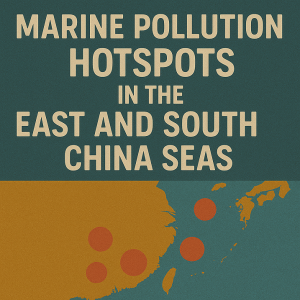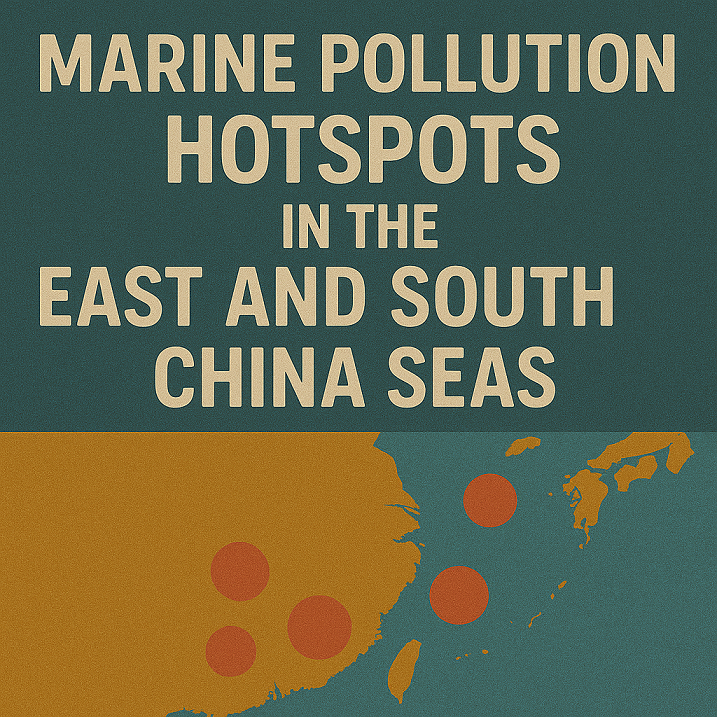Explore the key marine pollution hotspots in the East and South China Seas. Discover the causes, real-world impacts, and effective solutions shaping maritime sustainability across Asia’s busiest shipping zones.

Why Marine Pollution in the East and South China Seas Matters Today
The East and South China Seas form one of the world’s most active maritime corridors. With hundreds of ports, billions in maritime trade, and dense coastal populations, this region plays a crucial role in both global logistics and marine biodiversity. However, beneath the surface lies a growing environmental emergency. These waters are among the most heavily polluted marine areas on the planet. According to a 2023 report from the United Nations Environment Programme (UNEP), the South China Sea ranks as one of the top five marine pollution hotspots globally.
Why does this matter? Because the pollution crisis in these seas threatens marine ecosystems, coastal economies, human health, and maritime operations. Polluted waters result in dead zones, reduced fish stocks, coral reef degradation, and increased risks for maritime workers. As of 2024, the IMO and ICS have emphasized that environmental degradation in key maritime routes is no longer just an ecological issue – it is a shipping risk and a regulatory challenge.
Understanding the Geography of Pollution Hotspots
Both seas are semi-enclosed bodies of water bordered by major industrial and agricultural economies: China, Japan, South Korea, Vietnam, the Philippines, and Taiwan. The water circulation patterns here are slow, which means pollutants do not disperse quickly. Instead, they accumulate.
Some of the most severely affected hotspots include:
- The Yangtze River Estuary and Shanghai Port area
- The Pearl River Delta and Hong Kong coastal waters
- The Bohai Sea, often called the most polluted sea in China
- The Manila Bay in the Philippines
- Vietnam’s Mekong Delta outflow areas
- Hainan Island coastal zone
These areas are not just vital to regional economies; they are also ecologically sensitive zones containing coral reefs, mangroves, and estuaries that serve as nurseries for marine life.
Sources and Types of Marine Pollution in the Region
Land-Based Sources: The Silent Majority
According to the World Bank, over 80% of marine pollution in the East and South China Seas originates from land-based activities. This includes:
- Agricultural runoff (fertilizers and pesticides)
- Industrial waste and heavy metals (lead, mercury, cadmium)
- Urban wastewater (often untreated)
- Plastics and microplastics
The Yangtze River alone carries over 1.5 million tons of plastic waste into the East China Sea every year (Jambeck et al., 2015, updated 2021). This makes it one of the world’s largest contributors to marine plastic pollution.
Shipping and Port Operations
As per Clarksons Research and MarineTraffic, the East and South China Seas see more than 70,000 vessel movements per year. This heavy traffic brings with it pollution risks:
- Bilge water discharge
- Ballast water introducing invasive species
- Oil spills and bunker fuel leaks
- Paint particles and anti-fouling toxins
In 2022, the Maritime Safety Administration of China (MSA) reported 68 oil spill incidents along Chinese coasts, with significant environmental damage.
Fishing and Aquaculture
Illegal, unreported, and unregulated (IUU) fishing activities are rampant, especially in the Spratly and Paracel Islands. Overfishing, destructive trawling, and discarded fishing gear contribute to habitat loss and ocean floor degradation. Meanwhile, poorly managed aquaculture (especially shrimp and tilapia farms) releases excess nutrients and antibiotics into the sea.
Atmospheric Deposition
Emissions from coal power plants, vehicles, and factories eventually deposit pollutants like nitrogen oxides and sulfur dioxide into marine environments. These contribute to ocean acidification and eutrophication (algae blooms).
Case Studies: Pollution Hotspots and Local Realities
Bohai Sea: A Semi-Enclosed Disaster Zone
Surrounded by China’s most industrialized regions (Beijing, Tianjin, and Hebei), the Bohai Sea receives pollutants from over 30 rivers. The sea has low water exchange with the open ocean, making it prone to stagnation. A 2022 study in the Marine Pollution Bulletin found that over 50% of its waters are considered “heavily polluted” based on nutrient and metal concentrations.
Despite the establishment of a “no new chemical plants” policy in 2020, legacy pollution and sediment contamination remain serious problems.
Manila Bay: The Cost of Urban Overload
Home to over 15 million people, Manila Bay has been a dumping ground for decades. Raw sewage, landfill overflow, plastics, and oil waste pour into its waters. The Philippine government launched a massive cleanup campaign in 2019, but illegal settlements and weak infrastructure continue to undermine progress.
A 2023 report from WWF Philippines noted that plastic density in the bay’s waters was three times higher than the ASEAN regional average.
Pearl River Delta and Hong Kong Waters
In one of Asia’s largest megaregions, the Pearl River Delta, rapid urbanization and industrialization have outpaced environmental controls. Eutrophication, red tides, and hypoxia events (low oxygen levels) now occur with increasing frequency.
Hong Kong’s Environmental Protection Department reported 42 red tide incidents in 2022 alone, affecting fisheries and water quality. These were linked to upstream nutrient loading and algal blooms exacerbated by warming temperatures.
Solutions: Charting a Course for Cleaner Seas
Stronger Maritime Regulations and Port Controls
The International Maritime Organization (IMO) and regional governments have taken steps to reduce pollution from ships. MARPOL Annex V (garbage), Annex VI (air pollution), and Annex I (oil discharge) are now being more rigorously enforced. Ports like Singapore and Shanghai have implemented shore power, emission control zones, and mandatory oily water separator checks.
Paris MoU port state control inspections have also flagged numerous ships in Chinese and Korean waters for environmental violations, including oily discharge and improper waste logs.
Land-Based Pollution Management
China’s “Action Plan for Prevention and Control of Water Pollution” (2015–2025) focuses on treating industrial wastewater and reducing runoff into marine environments. The plan includes:
- Upgraded municipal treatment plants
- Strict effluent standards for polluting industries
- Buffer zones and wetland rehabilitation
Similar efforts are underway in Vietnam and the Philippines, supported by the Asian Development Bank (ADB) and World Bank.
Plastic Waste Reduction Initiatives
Several regional campaigns have emerged:
- China’s national ban on single-use plastics (rolled out from 2020 to 2025)
- The ASEAN Regional Action Plan for Combating Marine Debris (2021–2025)
- NGO-led cleanups such as Greenpeace East Asia and Ocean Conservancy projects
Local programs like the “Zero Waste Cities” initiative in Vietnam and community recycling in the Philippines also show promising grassroots solutions.
Smart Technology and Satellite Monitoring
- Inmarsat and AIS (Automatic Identification System) data help identify illegal discharges and track vessels violating emissions protocols.
- Remote sensing satellites like Sentinel-3 monitor water turbidity, chlorophyll concentration, and oil slicks.
- Citizen science platforms, such as Global Fishing Watch, empower communities to report pollution and illegal fishing.
These tools create accountability in a region where enforcement is often underfunded or politicized.
Challenges Ahead: What Still Stands in the Way?
Jurisdictional Complexity and Territorial Disputes
Overlapping claims in the South China Sea hinder regional cooperation. Environmental regulations often become secondary to geopolitical concerns. Disputes between China, Vietnam, and the Philippines have delayed joint efforts in marine monitoring and disaster response.
Data Gaps and Transparency
Despite growing attention, many pollution hotspots lack consistent, long-term data. This hampers policymaking and international collaboration. Efforts by the UNEP Regional Seas Programme and NOWPAP (Northwest Pacific Action Plan) are addressing this, but progress is slow.
Industrial Resistance and Political Will
Pollution control often conflicts with short-term economic goals. Industries lobbying against strict effluent rules, coupled with uneven enforcement, undermine progress. In some countries, environmental laws exist but are poorly implemented due to budget or corruption constraints.
Future Outlook: From Hotspots to Blue Hope
Despite the grim statistics, change is happening. The integration of environmental metrics into port performance indicators, growing consumer pressure for “green shipping,” and the increasing role of digital monitoring provide reasons for cautious optimism.
Looking ahead, the following strategies will be critical:
- Regional marine environmental governance (e.g., a SCS Environmental Pact)
- Blue economy investment in sustainable shipping and fisheries
- Scaling up coral reef and mangrove restoration projects
- Maritime education and training focused on pollution prevention (e.g., through IMO Model Courses and Maritime Academies)
The East and South China Seas need not remain pollution hotspots. With science-based policies, regional cooperation, and technological innovation, they can become examples of marine recovery and resilience.
FAQ: Marine Pollution in the East and South China Seas
What is the main cause of marine pollution in these seas?
Primarily land-based pollution, including wastewater, plastics, and agricultural runoff.
How does marine pollution affect maritime trade?
Pollution reduces water quality, damages port infrastructure, and can lead to regulatory penalties for shipping companies.
Which countries are most affected?
China, the Philippines, Vietnam, and South Korea are among the most impacted due to their coastal density and maritime activities.
Are international regulations helping?
Yes, MARPOL and port state controls have improved compliance, but enforcement gaps remain in some areas.
Can technology help monitor and reduce pollution?
Absolutely. Satellites, AIS tracking, and AI data analytics are being used to monitor hotspots and enforce regulations.
How can individuals contribute?
Avoid single-use plastics, support eco-certified seafood, and participate in local cleanups or marine advocacy campaigns.
Conclusion: A Shared Sea, A Shared Responsibility
Marine pollution in the East and South China Seas is not an isolated problem. It is a shared crisis with global consequences. From shipping lanes and fishing zones to coral reefs and coastal communities, pollution affects every link in the maritime chain.
But solutions exist. With unified commitment from governments, industries, and individuals, it’s possible to reverse the damage and create a future where maritime development and ocean health go hand in hand. Clean seas are not just a dream – they are a duty we all share.
References
- UNEP. (2023). State of the Marine Environment in Asia-Pacific. https://www.unep.org
- Marine Pollution Bulletin. (2022). “Eutrophication and Nutrient Loading in the Bohai Sea.”
- WWF Philippines. (2023). Plastic Pollution in Manila Bay. https://wwf.org.ph
- MarineTraffic. Vessel Movements and Port Data. https://www.marinetraffic.com
- IMO. (2024). MARPOL Annex Regulations. https://www.imo.org
- Clarksons Research. (2023). Global Fleet Statistics. https://www.clarksons.net
- Global Fishing Watch. (2023). Fishing Effort Data in the South China Sea. https://globalfishingwatch.org
- Ocean Conservancy. (2023). Combatting Marine Debris. https://oceanconservancy.org
- MSA China. (2022). Oil Spill Incidents. http://en.msa.gov.cn
- Jambeck, J. et al. (2021). “Plastic waste inputs from land into the ocean.” Science.
- ADB. (2023). Clean Water Infrastructure in Coastal Cities. https://www.adb.org

